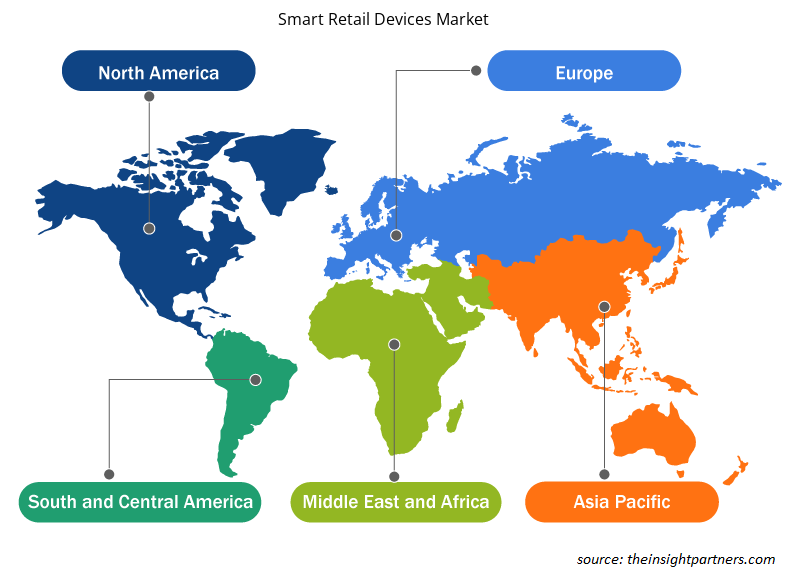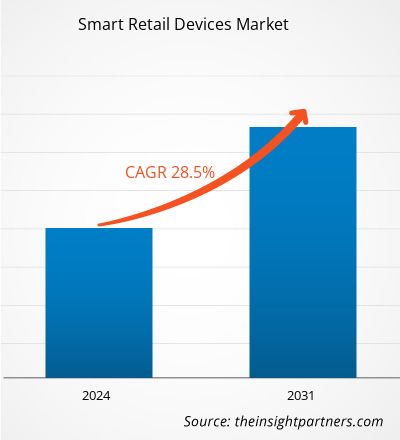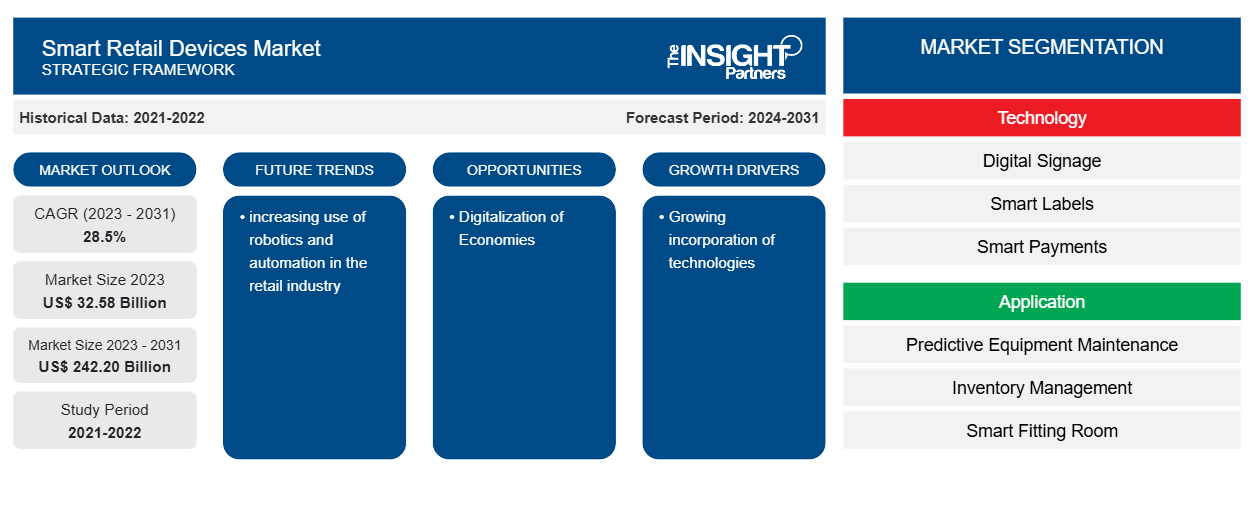Si prevede che le dimensioni del mercato dei dispositivi smart retail cresceranno da 32,58 miliardi di dollari nel 2023 a 242,20 miliardi di dollari entro il 2031; si prevede che si espanderà a un CAGR del 28,5% dal 2024 al 2031. È probabile che l'uso crescente della robotica e dell'automazione nel settore della vendita al dettaglio rimanga una tendenza chiave del mercato dei dispositivi smart retail.CAGR of 28.5% from 2024 to 2031. The increasing use of robotics and automation in the retail industry is likely to remain a key smart retail devices market trends.
Analisi di mercato dei dispositivi intelligenti per la vendita al dettaglio
La crescente adozione dell'analisi dei big data e dell'Internet of Things (IoT) nel settore della vendita al dettaglio, insieme all'aumento del potere d'acquisto dei consumatori, rappresentano i principali fattori trainanti per il mercato dei dispositivi intelligenti per la vendita al dettaglio.IoT) in the retail industry along with the surge in purchasing power of consumers are major driving factors for the smart retail devices market.
Panoramica del mercato dei dispositivi intelligenti per la vendita al dettaglio
Lo smart retail è l'uso di tecnologia e dati per migliorare le esperienze di acquisto dei clienti e le operazioni delle aziende. Queste tecnologie consentono alle organizzazioni di migliorare l'esperienza del cliente, semplificare le procedure e ottenere informazioni importanti sul comportamento dei consumatori. Questi gadget connessi a Internet consentono agli utenti di accedere facilmente a informazioni e servizi personalizzati, mentre funzionalità sofisticate come il riconoscimento vocale e l'integrazione del touchpad rendono lo shopping un gioco da ragazzi, con assistenti virtuali che guidano i consumatori a selezionare i beni giusti , esaminare offerte interessanti, effettuare acquisti e persino catturare e condividere esperienze sui social media.touchpad integration make shopping a breeze, with virtual assistants leading consumers to select the right
Personalizza questo report in base alle tue esigenze
Riceverai la personalizzazione gratuita di qualsiasi report, comprese parti di questo report, o analisi a livello nazionale, pacchetto dati Excel, oltre a usufruire di grandi offerte e sconti per start-up e università
-
Scopri le principali tendenze di mercato in questo rapporto.Questo campione GRATUITO includerà analisi di dati che spaziano dalle tendenze di mercato alle stime e alle previsioni.
Driver e opportunità di mercato per i dispositivi di vendita al dettaglio intelligenti
Crescente integrazione di tecnologie per favorire il mercato
L'integrazione di tecnologie come l'intelligenza artificiale (AI), la realtà virtuale (VR), la realtà aumentata (AR) e l'Internet of Things (IoT) viene sempre più utilizzata nel settore della vendita al dettaglio per migliorare l'esperienza di acquisto, migliorare la gestione dell'inventario e semplificare le operazioni del negozio. L'Internet of Things (IoT) è una componente importante nell'ambiente di vendita al dettaglio intelligente perché collega i gadget a Internet e offre dati vitali sul comportamento dei clienti, sulle operazioni del negozio e sulla gestione dell'inventario. I dispositivi IoT, come sensori e beacon, consentono ai commercianti di raccogliere dati in tempo reale sui livelli di inventario, sul flusso dei clienti e sulle risorse del negozio, consentendo loro di prendere decisioni più consapevoli e ottimizzare le operazioni.
Digitalizzazione delle economie
L'uso della digitalizzazione offre diversi vantaggi ai negozi, tra cui l'acquisizione di nuovi consumatori e la riduzione dei costi operativi. Inoltre, la digitalizzazione ha la capacità di incoraggiare significativamente il personale di vendita al dettaglio. Di conseguenza, i rivenditori potrebbero vedere un aumento dei loro ricavi. In particolare, lo shopping non in negozio ha assistito a una crescita significativa nell'anno 2020. È probabile che i punti vendita al dettaglio online trarranno enormi benefici dai miglioramenti tecnologici, dall'aumento della connessione, dall'introduzione di nuovi sensori e dalla disponibilità di soluzioni di comunicazione senza interruzioni , contribuendo quindi in modo significativo alla crescita del mercato durante tutto il periodo di previsione.digitalization provides several benefits to shops, including the acquisition of new consumers and the reduction of operational costs. Additionally, digitization has the ability to significantly encourage retail staff. As a result, retailers may see an increase in their revenues. Notably, non-store shopping witnessed significant growth in the year 2020. Online retail outlets are likely to benefit tremendously from technological improvements, increased connection, the introduction of novel sensors, and the availability of seamless
Analisi della segmentazione del rapporto di mercato sui dispositivi di vendita al dettaglio intelligenti
I segmenti chiave che hanno contribuito alla derivazione dell'analisi di mercato dei dispositivi intelligenti per la vendita al dettaglio sono la tecnologia e l'applicazione.
- In base alla tecnologia, il mercato è suddiviso in segnaletica digitale, etichette intelligenti, pagamenti intelligenti, carrelli intelligenti e altri. Il segmento della segnaletica digitale ha detenuto una quota di mercato maggiore nel 2023.
- In termini di applicazione, il mercato è suddiviso in manutenzione predittiva delle attrezzature, gestione dell'inventario, camerino intelligente, monitoraggio del traffico pedonale e altri. Il segmento della gestione dell'inventario ha detenuto una quota di mercato maggiore nel 2023.
Analisi della quota di mercato dei dispositivi intelligenti per la vendita al dettaglio per area geografica
L'ambito geografico del rapporto di mercato sui dispositivi Smart Retail è suddiviso principalmente in cinque regioni: Nord America, Asia Pacifico, Europa, Medio Oriente e Africa e Sud America/Sud e Centro America. Il Nord America ha dominato il mercato dei dispositivi Smart Retail nel 2023. Si prevede che questa regione sarà il principale generatore di entrate nel mercato durante l'intero periodo di tempo previsto. Il crescente desiderio di prodotti di fascia alta e articoli di lusso, unito ai dinamici cambiamenti nelle preferenze dei clienti verso esperienze di vendita al dettaglio più convenienti ed efficienti in termini di tempo, sono i principali fattori che guidano questa tendenza. Inoltre, l'ampia integrazione della tecnologia digitale in vari settori sta rimodellando l'economia statunitense. Le conseguenze della pandemia hanno notevolmente accelerato la trasformazione digitale delle aziende nel settore della vendita al dettaglio, superando le aspettative precedenti.
Approfondimenti regionali sul mercato dei dispositivi intelligenti per la vendita al dettaglio
Le tendenze regionali e i fattori che influenzano il mercato degli Smart Retail Devices durante il periodo di previsione sono stati ampiamente spiegati dagli analisti di Insight Partners. Questa sezione discute anche i segmenti e la geografia del mercato degli Smart Retail Devices in Nord America, Europa, Asia Pacifico, Medio Oriente e Africa e America centrale e meridionale.

- Ottieni i dati specifici regionali per il mercato dei dispositivi di vendita al dettaglio intelligenti
Ambito del rapporto di mercato sui dispositivi di vendita al dettaglio intelligenti
| Attributo del report | Dettagli |
|---|---|
| Dimensioni del mercato nel 2023 | 32,58 miliardi di dollari USA |
| Dimensioni del mercato entro il 2031 | 242,20 miliardi di dollari USA |
| CAGR globale (2023-2031) | 28,5% |
| Dati storici | 2021-2022 |
| Periodo di previsione | 2024-2031 |
| Segmenti coperti |
Per tecnologia
|
| Regioni e Paesi coperti |
America del Nord
|
| Leader di mercato e profili aziendali chiave |
|
Densità degli attori del mercato: comprendere il suo impatto sulle dinamiche aziendali
Il mercato dei dispositivi Smart Retail sta crescendo rapidamente, spinto dalla crescente domanda degli utenti finali dovuta a fattori quali l'evoluzione delle preferenze dei consumatori, i progressi tecnologici e una maggiore consapevolezza dei vantaggi del prodotto. Con l'aumento della domanda, le aziende stanno ampliando le loro offerte, innovando per soddisfare le esigenze dei consumatori e capitalizzando sulle tendenze emergenti, il che alimenta ulteriormente la crescita del mercato.
La densità degli operatori di mercato si riferisce alla distribuzione di aziende o società che operano in un particolare mercato o settore. Indica quanti concorrenti (operatori di mercato) sono presenti in un dato spazio di mercato in relazione alle sue dimensioni o al valore di mercato totale.
Le principali aziende che operano nel mercato dei dispositivi intelligenti per la vendita al dettaglio sono:
- Società Intel
- Gruppo Samsung
- NVIDIA CORPORAZIONE
- Elettronica LG
- Società di tecnologie Zebra
- Caper Inc.
Disclaimer : le aziende elencate sopra non sono classificate secondo un ordine particolare.

- Ottieni una panoramica dei principali attori del mercato dei dispositivi Smart Retail
Notizie di mercato e sviluppi recenti sui dispositivi di vendita al dettaglio intelligenti
Il mercato dei dispositivi smart retail viene valutato raccogliendo dati qualitativi e quantitativi dopo la ricerca primaria e secondaria, che include importanti pubblicazioni aziendali, dati associativi e database. Di seguito è riportato un elenco degli sviluppi nel mercato:
- A giugno 2023, Intel e Vericast hanno unito le forze per sviluppare, implementare e valutare una rete di media digitali programmabili all'avanguardia per il retail in-store. Questo sistema innovativo sfrutta la tecnologia di targeting avanzata di Vericast e le potenti piattaforme software Edge di Intel per offrire pubblicità e dettagli di prodotto personalizzati che si allineano al percorso di acquisto del cliente. Questa collaborazione è una componente fondamentale della nostra più ampia iniziativa per rivoluzionare il settore del retail e capitalizzare la trasformazione digitale dei negozi fisici, che è ampiamente considerata la prossima grande tendenza nel settore pubblicitario.
(Fonte: Intel, Comunicato stampa, 2023)
- A novembre 2023, Panasonic Connect Europe ha introdotto una nuova soluzione basata sull'intelligenza artificiale che mira a trasformare il settore della vendita al dettaglio personalizzando la pubblicità tramite assistenti AI generativi per i clienti mentre fanno acquisti. Questa soluzione innovativa consente ai negozi di monitorare automaticamente i dati demografici degli acquirenti e di combinare queste informazioni con preferenze di acquisto, dati meteorologici ed eventi locali per personalizzare all'istante la pubblicità sui display in negozio. Panasonic ha stretto una partnership con ADEAL Systems, uno specialista leader in dati e intelligenza artificiale, per integrare il suo assistente personale per lo shopping basato sull'intelligenza artificiale, CUSAAS (Customer Segmentation As-A-Service), con soluzioni di telecamere e display all'avanguardia per la tecnologia di vendita al dettaglio, creando un'esperienza di acquisto migliorata.
(Fonte: Panasonic, Comunicato stampa, 2023)
Copertura e risultati del rapporto di mercato sui dispositivi di vendita al dettaglio intelligenti
Il rapporto "Dimensioni e previsioni del mercato dei dispositivi intelligenti per la vendita al dettaglio (2021-2031)" fornisce un'analisi dettagliata del mercato che copre le seguenti aree:
- Dimensioni e previsioni del mercato a livello globale, regionale e nazionale per tutti i segmenti di mercato chiave coperti dall'ambito
- Dinamiche di mercato come fattori trainanti, vincoli e opportunità chiave
- Principali tendenze future
- Analisi dettagliata delle cinque forze PEST/Porter e SWOT
- Analisi di mercato globale e regionale che copre le principali tendenze di mercato, i principali attori, le normative e gli sviluppi recenti del mercato
- Analisi del panorama industriale e della concorrenza che copre la concentrazione del mercato, l'analisi della mappa di calore, i principali attori e gli sviluppi recenti
- Profili aziendali dettagliati
- Analisi storica (2 anni), anno base, previsione (7 anni) con CAGR
- Analisi PEST e SWOT
- Valore/volume delle dimensioni del mercato - Globale, Regionale, Nazionale
- Industria e panorama competitivo
- Set di dati Excel
Report recenti
Testimonianze
Motivo dell'acquisto
- Processo decisionale informato
- Comprensione delle dinamiche di mercato
- Analisi competitiva
- Analisi dei clienti
- Previsioni di mercato
- Mitigazione del rischio
- Pianificazione strategica
- Giustificazione degli investimenti
- Identificazione dei mercati emergenti
- Miglioramento delle strategie di marketing
- Aumento dell'efficienza operativa
- Allineamento alle tendenze normative























 Ottieni un campione gratuito per - Mercato dei dispositivi intelligenti per la vendita al dettaglio
Ottieni un campione gratuito per - Mercato dei dispositivi intelligenti per la vendita al dettaglio